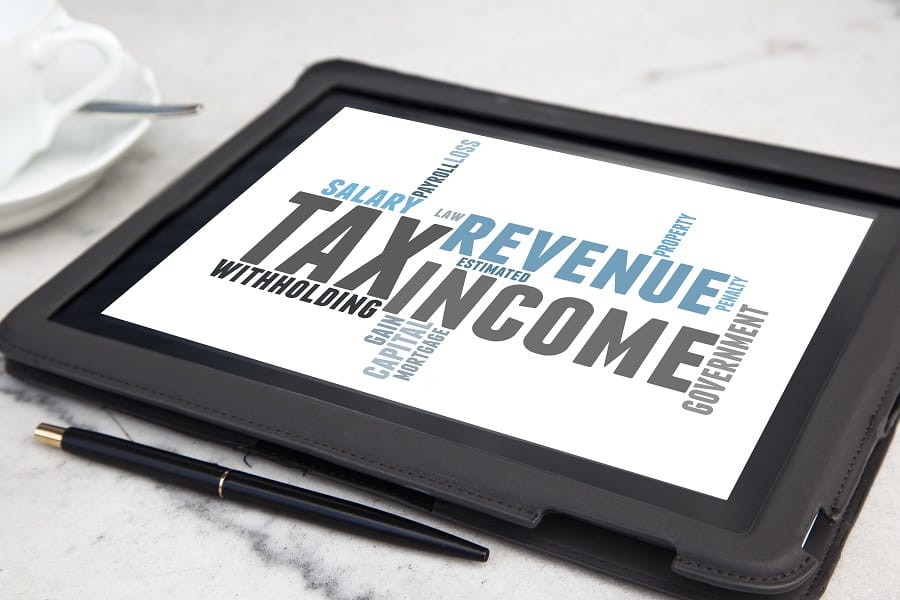Payroll withholding refers to the process of setting aside a portion of employee wages for taxes. These wages are withheld from an employee’s gross pay – the total amount they’re owed for a completed pay period.
What is a Payroll Tax Withholding?
Written by: Coralee Bechteler
Coralee is a business writer with experience in administrative services, education, and software testing.
Reviewed by: Daniel Eisner
Daniel Eisner is a payroll specialist with over a decade of practical experience in senior accounting positions.
Updated on July 21, 2024

Paying taxes is a necessary duty, and payroll taxes are no exception. Making sure withholdings are correct for each employee is a crucial task, especially for businesses with large staff.
Employers must make sure a portion of employees’ wages are withheld each pay period or face penalties. Additionally, business owners and their HR teams are required to allocate taxes to corresponding federal, state, and local governments.
This guide explains the concept of payroll withholding and details every step of the process to ensure your business stays on track for success.
What Is Payroll Withholding?
The amount left over after all withholdings and deductions have been made is their net pay, or “take-home pay” – and thus the amount that appears in their paycheck.
An employee’s income and circumstances determine the amount to be withheld from their pay. Most of the taxes withheld are either federal or state income taxes or unemployment taxes.

Where Are Employee Withholdings Specified?
A W-4 form is a government document that contains all of the information an employer needs to determine how much of an employee’s wages to set aside to fulfill their tax obligations.
The form details an employee’s filing status, which conveys their marital status and family situation. It also collects how many jobs an employee has, their allowances, and their number of dependents.
Businesses typically provide new hires with a W-4 form during the onboarding process. You can download the latest version of Form W-4 from the Internal Revenue Service website.
Form W-4 vs. Form W-2
A W-4 form is a document that tells employers how much to withhold from an employee’s wages for tax payments. A W-2 form details how much an employee was paid during a given year, and how much in taxes were withheld.
A W-4 is filled out by the employee and delivered to the employer. The W-4 does not need to be filed with the Social Security Administration.
Conversely, a W-2 form is filled out by the employer and filed with the Social Security Administration, and must be provided to each employee every year by the end of January.
Why Withhold Payroll Taxes?
When an employer withholds and pays the applicable taxes for their employees, it’s one less thing employees need to worry about when filing personal tax returns. Without employer withholdings, each employee would be responsible for setting aside the right amount of wages to pay their own taxes.
If there are any errors in their calculations or they fail to save enough money throughout the tax year, they could face a surprisingly large payment when taxes are due. Moreover, withholding taxes reduces an employee’s annual tax payment and could even result in a refund.
Are Businesses Required to Withhold Payroll Taxes?
Businesses are required by law to withhold employee wages for certain taxes and make regular tax payments on their employees’ behalf. Additionally, business owners must file a quarterly return for employees’ withheld federal income tax, Social Security, and Medicare taxes.
What Payroll Taxes Are Employers Required to Withhold?
The amount of a given employee’s withheld wages hinge on their circumstances and household. Some of the most common withholdings stem from federal and state income taxes and unemployment taxes.
Federal Income Tax
The US federal government requires each citizen to pay income tax. Each state may have its own specific income tax requirements as well. To determine how much should be withheld from an employee’s federal income taxes, use the information provided on their W-4 and the current federal income tax rate.
Each state with an income tax requirement typically requires employers in that state to have employees complete a state-specific income tax form, which can usually be found on the state’s Secretary of State or Department of Revenue website. Employers need to stay on top of any rate changes or new laws to ensure their withholdings are correct.
Federal Insurance Contributions Act Taxes (FICA)
The current FICA tax rate for employees is 7.65%. But note that FICA taxes are actually two separate taxes that under one withholding tax umbrella:
- Social Security taxes
- 6.2% of employee wages
- Medicare taxes
- 1.45% of employee wages
Employers are required to match, withhold, and forward their employees’ FICA taxes to the federal government.
Keep in mind, however, that the federal government maintains an annual contribution and benefit base limit, which identifies the maximum amount of wages subject to Social Security taxation. This base limit changes every year; in 2022, the amount is $147,000.
Medicare taxes have no contribution limit, which means all wages earned by an employee are subject to this 1.45% tax.
- Additional Medicare Tax Withholding
Businesses with employees that earn wages that exceed a certain amount in a calendar year must withhold an additional 0.9% of their wages for Additional Medicare Taxes. This extra withholding tax must commence in the pay period in which the employee’s year-to-date (YTD) earnings surpasses the wage threshold.
But how do you know if an employee qualifies for additional medicare tax withholdings? In addition to an employee’s YTD wages, the filing information detailed in their W-4 form helps determine their threshold for withholding additional Medicare taxes.
- An Additional Medicare Tax Example
Here’s an example of how an employee could be affected by additional Medicare tax withholdings. For an employee who earns $205,000 in a calendar year:
- If the employee files as a single individual, they’re required to pay the Additional Medicare Tax
- If the employee is married but files as a separate individual, they’re required to pay the Additional Medicare Tax
- If the employee is married and files jointly, they’re not required to pay the Additional Medicare Tax
- If the employee files as the head of household, they’re required to pay the Additional Medicare Tax
- If the employee files as a widower with a dependent, they’re required to pay the Additional Medicare Tax
| Filing Status | Threshold Amount |
|---|---|
| Married filing jointly | $250,000 |
| Married filing separate | $125,000 |
| Single | $200,000 |
| Head of household (with qualifying person) | $200,000 |
| Qualifying widow(er) with dependent child | $200,000 |
You can learn more about Additional Medicare Tax withholding from the IRS publication here.
State and Local Income Taxes
Depending on the state in which a business is located, additional payroll tax deductions may be required. Be sure to check with your state and local government to ensure compliance.
Employees Exempt from Withholding
Qualifying employees can request that their federal income taxes are not withheld by their employer by submitting withholding tax forms. In this case, the W-4 form acts as a withholding exemption certificate. The IRS states that to qualify, an employee must satisfy two requirements:
- In the previous year, the employee must not have had any tax liability
- In the current year, the employee must expect no tax liability
An employee W-4 that requests federal income tax withholding not be deducted from their wages is only valid for one year. If the employee wishes to remain exempt from federal income tax withheld in the following year, they must submit a new W-4 form specifying this request by February 15.
If the employee fails to do so, HR should withhold taxes reflective of someone filing as a single individual, or as a married individual filing separately.
Do Businesses Need to Keep Records of Employee Payroll Withholdings?
Government agencies regularly institute new recordkeeping laws and regulations. These requirements apply to payroll records and payroll tax withholding records, as well.
- The Equal Employment Opportunity Commission, or EEOC, requires that all employment records be retained for one year.
- The Age Discrimination in Employment Act, or ADEA, requires that payroll records be retained for at least three years.
- The Fair Labor Standards Act, or FLSA, also requires that payroll records be retained for three years.
- The IRS requires that businesses retain employee W-4 forms for at least four years.
- The International Revenue Service, or IRS, recommends that all payroll records be kept and maintained for six years.
We recommend that employers store all employee payroll withholding records for six years, which is the most prolonged required retention period. After six years, HR can initiate disposal with confidence.
The information your HR team needs to retain regarding each employee’s payroll records includes the following:
- Employee name, address, Social Security number, and company role
- Employee start date and (if applicable) end date
- Pay period’s start and end dates
- Employee’s daily hours and total hours for the pay period
- Whether it’s an hourly or salaried employee
- Wage rate and total wages for the pay period
- Benefits:
- Pension payments
- Retirement plans
- Paid time off
- Additions and deductions:
- Overtime
- Bonuses
- Commissions
- Tips
- Overpayment correction
- 401K
- Multiple forms:
- W-2
- W-3
- W-4, W-4P, W-4S, W-4V
- W-5
- 941 or 944

Can a Payroll Service Handle Payroll Tax Withholding?
Payroll withholdings are daunting! Businesses can save themselves the hassle of calculating and executing payroll tax withholding by outsourcing payroll to an established service provider. Companies that lack the funding or capacity to outsource payroll might consider investing in payroll accounting software to track wages and ensure accurate bookkeeping.
Payroll services and software often free up HR to focus on other key business functions and provide business owners with peace of mind knowing all payroll concerns have been addressed.
Should Employees Review or Change their Withholding?
It’s in the best interest of an employee to take the time to review their W-4 and withheld taxes every year so that their withholdings reflect their circumstances and needs. Certain life changes can dramatically impact the taxes withheld, such as:
- Significant change in income
- Promotion or demotion
- Marriage or divorce
- Adding or removing dependents
- Buying a house
Reviewing and making changes to payroll tax withholdings can help prevent a large taxpayer bill or even penalties. Similarly, it can support an employee taking home a larger paycheck and receiving a smaller tax refund.
Conclusion
You’re now armed with a solid understanding of payroll tax withholdings and their importance. When your employee income tax withholdings are done properly, it’s a win-win for your workforce, the government, and your business, so always be sure to comply.
